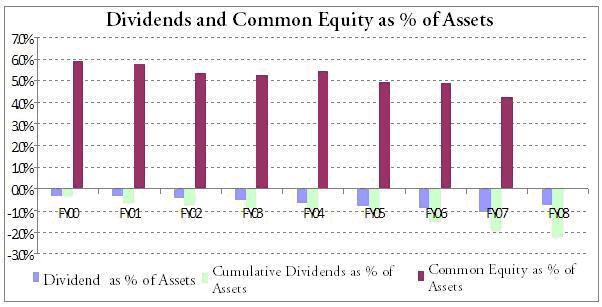Since August 2007, banks have accumulated losses of $1.11 trillion in the current crisis. But what is striking is that banks have continued to pay out dividends, even though the value of common equity has suffered immensely. Acharya et al. (2009) argue that dividend payments represent a transfer to equity holders from creditors (and taxpayers) in violation of the priority of debt over equity. Furthermore, the dwindling pool of common equity may be an important reason for the continued reluctance of banks to extend credit in spite of the large-scale injection of bailout capital.
Figure 1 shows that bank dividend payouts increased from 0.4% of assets in 2000 to 1.1% of assets in 2007. Through the first three quarters of 2008 they were still at 0.7% of assets – that is, banks barely reduced their dividends in the first fifteen months of the crisis.
Figure 1. Dividends and common equity as a percentage of assets
Source: Acharya et al. (2009)
At the end of 2008, the volume of interbank lending in the British currency fell to £205 billion down from £635 billion in July 2007 and down 24% from the average since the credit crunch started in August 2007, and 38% for the five years ending December 2006. We argue that market-based regulation, which affects all participants in a particular market (in this case the interbank market), curtailing the payout of dividends, increases the liquidity of borrowers in the interbank market, stimulates trade in the market and ultimately improves the welfare of consumers.
Liquidity and default have frequently been regarded as two separable concepts. Our view, instead, is that these two concepts are inherently intertwined – you can’t have one without the other. For example, if no one ever defaulted, and was without any credit risk, then everyone's IOU would be perfectly acceptable in payment. The concept of gradations of liquidity in such circumstances would be invalid. There would be no need for money, nor for financial intermediaries. The assumption of zero default unfortunately lies at the heart of most of the macroeconomic models currently in mainstream use, which explains why they have been so spectacularly useless during the recent crisis.
In Goodhart et al. (2010) we concentrate on the collapse of the interbank market under counterparty risk and show that trade can be restored with the appropriate restrictions on dividends. The argument derives from Peiris and Vardoulakis (2010). They propose savings requirements as a way to stimulate trade when markets would otherwise be inactive. Moreover, they argue that trade in risky securities such as loans in the interbank market (and subsequently delivery rates in them) improve when agents hold greater amounts of liquid savings. In light of recent events in the financial markets, such a policy would be greatly beneficial. Given that the interbank market consists of an international array of banks, an internationally coherent approach to regulation is needed. Hence, we advocate market-based regulation, which is tied to participation in specific markets, as opposed to national, institution-based regulation.
One weakness of both Basel I and Basel II lies in their dependency on capital rather than liquidity. Defaults across asset classes become highly correlated during an economic downturn, often occurring unexpectedly. In such scenarios, what is needed is not only capital or assets, but also liquid capital or assets. This is precisely what is argued in this paper. Banks should hold greater amounts of liquid wealth as a precautionary means of meeting claims in times of crisis.
Modelling approach
To properly formulate such an argument and capture the many interrelated effects and channels requires a formal general equilibrium analysis incorporating money, banks, and default. Indeed, a formal welfare analysis can only be studied in such an environment, as each effect will have direct and indirect implications on the final allocation of consumption.
In Goodhart et al. (2010), our main objective is to describe a situation where the interbank market collapses and to then propose regulation that restores trade. Hence, we consider an environment with two heterogeneous banks that can enter into a contractual agreement to transfer funds between them. Banks are not obliged to honour this contract when the time for repayment comes, and thus, active default in the interbank market can occur in equilibrium. Defaulting banks are punished in their objective function as in Dubey et al. (2005) and Tsomocos (2003). When default penalties are low, adverse shocks in the anticipated future profits and capital position of banks can induce them to default completely in the interbank market, which collapses. We describe this situation and show how regulation on dividends can alleviate this problem. Banks optimising behaviour and their attitude towards risk are important elements in our analysis, since the possibility of default may deter banks from participating in the interbank market not only due to low profit expectation, but also due to high risk.
Our second consideration concerns the fairness of such a regulatory policy and its subsequent effect on welfare. Banks are financial intermediaries that extend credit to consumers and their purpose is to facilitate trade and risk-sharing. Formally, we consider a canonical General Equilibrium model with incomplete markets, commercial banks, fiat money and endogenous default. We consider two households that have utility for goods traded in the economy and receive credit from banks to fund their trade. Households cannot write their own contracts or promissory notes and exchange them for goods. They need money to acquire goods in the corresponding markets. In our model, we assume limited participation so that each household is affiliated with only one bank (and one bank with each household). Households maximise the utility of consumption. Apart from receiving credit from banks, households also receive dividends as they own stakes in both of them. The interaction of the real and nominal sectors of the economy allows us to focus on the effect of dividend restrictions on (individual) household welfare in order to evaluate the fairness of such a policy.
Banks will not voluntarily hold capital, since they can extend credit in the initial period and earn the (positive) interest rate. Nevertheless, once profits are realised, they cannot commit to retain the profits in order to accumulate reserves in the last period. Thus, the need for liquidity (capital) requirements arises. In the abstract debt market of Peiris and Vardoulakis (2010), this can restore trade in defaultable asset markets, since capital will be held when the contract is traded. But in Goodhart et al. (2010), we show that if banks can commit to not distribute dividends at the end of the period, then the effect will be the same as if they raised capital requirements. The issue of commitment is not simple and depends on corporate governance and regulation. For the purposes of this paper, we assume that banks can, indeed, commit not to distribute dividends. Government intervention through regulation can provide incentives for such a commitment.
Conclusion
The international nature of the modern interbank (loan) market demands a coherent approach to regulation. Here we advocate market-based regulation, which affects all participants in a particular market, on the proper functioning of the interbank market. Specifically, we argue that restrictions on the payout of dividends by banks can reduce their expected default on (interbank) loans and hence stimulate trade in this market. The payout of dividends during a crisis is clearly of concern for debt holders. However, payouts may, in fact, also be to the detriment of equity holders. We argue that a reduction in the fraction of dividends paid out to shareholders allows banks greater access to debt markets, especially the interbank capital market, when liabilities are due. We have shown in Goodhart et al. (2010) that even an extreme situation where the interbank market implodes can be remedied through the introduction of dividend restrictions and results in an improvement in the welfare of shareholders.
We have shown that the presence of a functioning interbank market results in lower consumer credit rates, more efficient trade and a superior final allocation for consumers. The result is surprising in as much as we only restricted the dividend payout policy of the borrowing bank, yet improved welfare of that bank's borrowers, and ultimately its shareholders. This result is encouraging, as it is a simple method to re-start financial trade. Furthermore, compared to other policies, such as quantitative easing, enforcing dividend restrictions is a relatively inexpensive mechanism for encouraging risk sharing in the financial markets.
The forthcoming regulatory architecture should recognise that there are markets that are “too important to fail” and not only banks that are “too big to fail”. So regulation should also be focused on “systemic markets” as well as “systemic institutions” and hence should be international, and market-based, as opposed to national and individualised (and hence not directly tied to participation in a particular market) restrictions on economic activity.
References
Acharya, Viral, Irvind Gujral, and Hyun Song Shin (2009), “Dividends and Bank Capital in the Financial Crisis of 2007-2009”, Working Paper.
Dubey P., Geanakoplos J., Shubik M. (2005), “Default and punishment in general equilibrium”, Econometrica 73(1), 1–37
Goodhart Charles A E, Udara Peiris, Dimitrios Tsomocos and Alexandros Vardoulakis (2010), “On Dividend Restrictions and the Collapse of the Interbank Market”, Annals of Finance, forthcoming.
Peiris Udara. and Alexandros Vardoulakis A.P (2010), “Savings and the Pessimistic Market”, Working Paper, University of Oxford.
Tsomocos D.P. (2003), “Equilibrium analysis, banking and financial instability”, Journal of Mathematical Economics 5–6, 619–655








